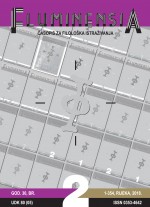ASSOCIATIVE STRENGTH AND FREQUENCY OF 228 NOUN COLLOCATIONS IN CROATIA
Keywords:
noun collocations, associative strength, frequency, Croatian as L2, native and foreign speakersAbstract
Research on collocational competence in Croatian as L1 (Ordulj and Cvikić 2017) and Croatian as second and foreign language (Ordulj 2016) has shown that the knowledge of noun collocations of native and non-native speakers is affected not only by morphological markedness, but also by frequency and associative strength of collocation components. Since there are no standardised data on associative strength of collocational components in the Croatian language, the aim of this paper is to examine data on associative strength and frequency of collocation components for 228 collocations having the basic adjective-noun structure, and to supplement the existing collocational dictionary that illustrates frequency (Ordulj 2016) with information about associative strength. Data on collocational associative strength was gathered from a sample of 283 native speakers of Croatian. By using a numerical scale, respondents evaluated the degree of association or connectedness of adjectives and nouns in collocations. Data on frequency for a particular collocation was gathered through corpus analysis in the hrWaC 2.1 corpus (Croatian Web Corpus – Ljubešić and Erjavec 2011). This analysis of frequency and associative strength of noun collocations will provide a better insight into psychological and linguistic characteristics of collocations, which are used in research on collocational competence in Croatian as L1 and Croatian as Second and Foreign Language (L2). Furthermore, this study will provide experts and teachers with a more systematic insight into the analysis of lexical bonds in Croatian, and the possibility of more adequate choice of examples for practicing collocational competence in Croatian as L2.

